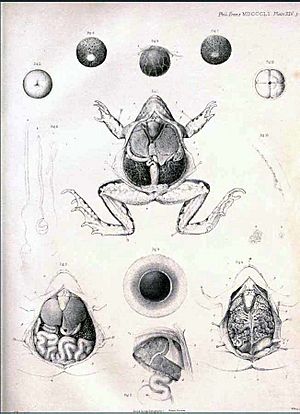George Newport facts for kids
George Newport was an important English entomologist. An entomologist is a scientist who studies insects. He was very good at using a microscope and at carefully taking apart tiny animals to study them.
Biography
George Newport was born on February 4, 1803, in Canterbury, England. He was the first of four children. His father, William Newport, was a local wheelwright, someone who built and repaired wheels.
George studied at London University and the London College of Surgeons. He became a Fellow of the Royal Society, which is a very respected group of scientists. From 1843 to 1844, he was the President of the Entomological Society of London. This is a group for people who study insects. He was also a member of the Ray Society, which publishes books about natural history.
Newport received two important awards for his scientific work: the Royal Medal in 1836 and the Royal Society Bakerian Medal in 1841. He passed away on April 7, 1854, in London and is buried in Kensal Green Cemetery.
Works and Discoveries
George Newport was known as one of the best anatomists of his time. This means he was excellent at studying the structure of living things. His research on insects and other arthropods (like spiders, centipedes, and crabs) was very important.
Some of his key publications include:
- On the Respiration of Insects (1836): This book was about how insects breathe.
- “Insecta,” in Todd's Cyclopædia of Anatomy and Physiology (1839): This was a section about insects in a large book on anatomy.
- On the Use of Antennæ of Insects (1840): This explained how insects use their feelers.
- List of Specimens of Myriopoda in the British Museum (1844): A list of the centipedes and millipedes he studied.
- Monograph of the Class Myriopoda, Order Chilopoda (1845): A detailed book specifically about centipedes.
Newport also studied how Amphibia (like frogs and salamanders) reproduce. His work, On the Impregnation of the Ovum in the Amphibia (1851), described how their eggs are fertilized. He also studied the early stages of how amphibian embryos develop.
He wrote about the nervous system (like the brain and nerves) and the circulatory system (how blood moves) in Myriapoda (centipedes and millipedes) and some types of Arachnida (spiders and scorpions). He showed that these creatures have a complete system for blood circulation. Newport also studied the nervous system of a specific moth, the Sphinx ligustri, during its pupa (cocoon) and adult stages.


